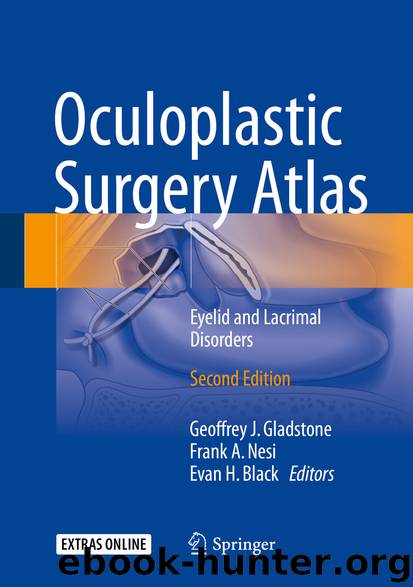Oculoplastic Surgery Atlas by Geoffrey J. Gladstone Frank A. Nesi & Evan H. Black

Author:Geoffrey J. Gladstone, Frank A. Nesi & Evan H. Black
Language: eng
Format: epub
Publisher: Springer International Publishing, Cham
Surgical Decision-Making
The most important factors in differentiating aponeurotic from muscular ptosis are history, Burke levator function, eyelid crease position, and fissure width in downgaze (Table 5.1). In aponeurotic ptosis the patient will typically have good levator function (between 12 and 18 mm). The history is that of gradual onset beginning in middle-to-later life. The eyelid crease is characteristically elevated. Since the levator muscle is stretched or detached, it does not perform the function of a check ligament in downgaze, and the fissure width in downgaze is narrowed and sometimes actually closed (Table 5.1).Table 5.1.Factors distinguishing aponeurotic from muscular ptosis
Download
This site does not store any files on its server. We only index and link to content provided by other sites. Please contact the content providers to delete copyright contents if any and email us, we'll remove relevant links or contents immediately.
| Anesthesiology | Colon & Rectal |
| General Surgery | Laparoscopic & Robotic |
| Neurosurgery | Ophthalmology |
| Oral & Maxillofacial | Orthopedics |
| Otolaryngology | Plastic |
| Thoracic & Vascular | Transplants |
| Trauma |
Periodization Training for Sports by Tudor Bompa(7929)
Why We Sleep: Unlocking the Power of Sleep and Dreams by Matthew Walker(6366)
Paper Towns by Green John(4808)
The Immortal Life of Henrietta Lacks by Rebecca Skloot(4264)
The Sports Rules Book by Human Kinetics(4081)
Dynamic Alignment Through Imagery by Eric Franklin(3925)
ACSM's Complete Guide to Fitness & Health by ACSM(3827)
Kaplan MCAT Organic Chemistry Review: Created for MCAT 2015 (Kaplan Test Prep) by Kaplan(3805)
Introduction to Kinesiology by Shirl J. Hoffman(3629)
Livewired by David Eagleman(3535)
The River of Consciousness by Oliver Sacks(3421)
The Death of the Heart by Elizabeth Bowen(3344)
Alchemy and Alchemists by C. J. S. Thompson(3300)
Descartes' Error by Antonio Damasio(3168)
Bad Pharma by Ben Goldacre(3107)
The Emperor of All Maladies: A Biography of Cancer by Siddhartha Mukherjee(2934)
The Gene: An Intimate History by Siddhartha Mukherjee(2929)
The Fate of Rome: Climate, Disease, and the End of an Empire (The Princeton History of the Ancient World) by Kyle Harper(2878)
Kaplan MCAT Behavioral Sciences Review: Created for MCAT 2015 (Kaplan Test Prep) by Kaplan(2823)
